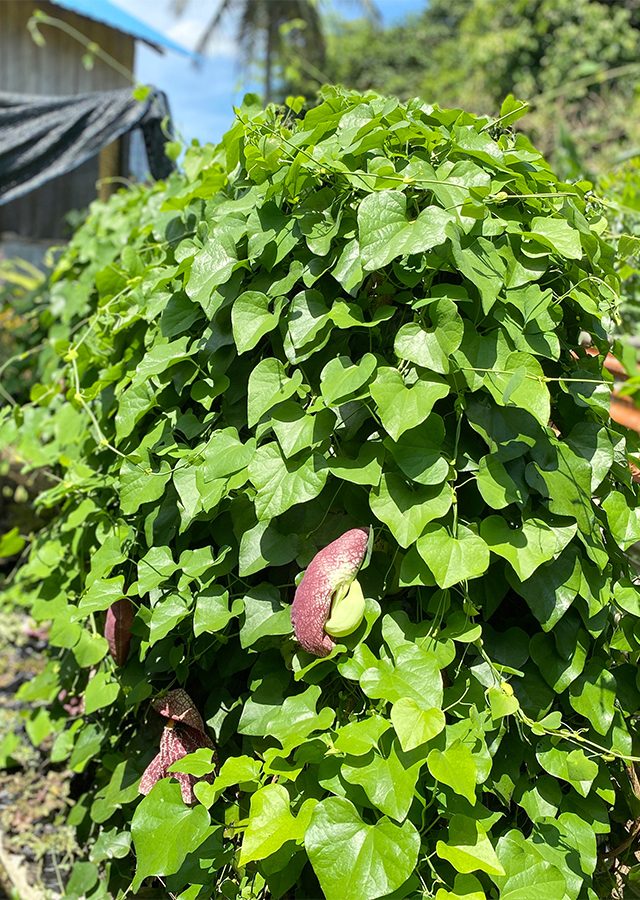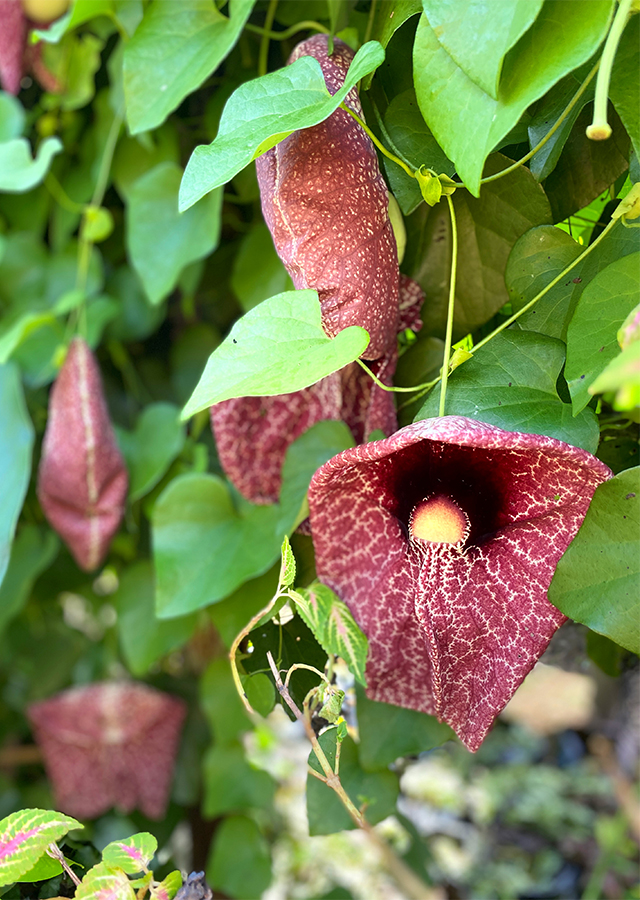Elegant Dutchman's Pipe
Aristolochia littoralis Parodi
Aristolochiaceae
Location in our garden
Green House



Synonym
Aristolochia elegans Mast.
Aristolochia elegans var. hassleriana (Chodat) Hassl.
Aristolochia hassleriana Chodat
Habitus
Climbers. Annual vines, grows up to 3-6 m
Part Used
Roots
Growing Requirements
Full Sunshine
Need Shade
Habitat
Riverbanks
Forest
Roadside
Overview
Originated from Argentina, Bolivia, Brazil, Colombia, Ecuador and Paraguay. This plant is usually used as an ornamental vine with attractive flowers of large size and very unique color, purplish and speckled petals. Extracts of this plant are also sometimes added to herbal supplements, as they are believed to have medicinal properties.
Vernacular Names
Flor de pato, Patico (Cuban).
Agroecology
Aristolochia littoralis prefers sandy to loamy soils in acid-neutral soil pH of 5.5 - 7.0 and average humidity, full sun to partial shade, at an altitude of about 10 - 1,150 m asl. The average temperature is 7 - 34 °C, and rainfall is 1,000 - 2,500 mm per year.
Morphology
- Roots - tap roots.
- Stems - slender and woody, up to 3 cm in diameter, old bark is dark brown showing certain layers in cross section.
- Leaves - smooth, hairless, heart-shaped, bean-shaped or ovoid with flat leaf margins (10 cm long, 12 cm wide). Occured in alternating leaf arrangements (single on alternating sides of the stem). Crushed leaves produce an unpleasant odor.
- Flowers - tubular, purple/dark red with white zigzag stripes and appear singly in leaf axils. Sessile anthers, 6 stamens, fused to form a structure about 6 x 5 mm around the style, style length about 7-8 mm; 6-locular ovary; many ovules at each locul. Flowers produce a smell like rotting flesh to attract pollinating flies.
- Fruits - capsule, cylindrical, 4.5 cm long and 2.5 cm in diameter. Pedicel with a length of about 5 cm split longitudinally into 6 strong wires like thread. The fruit opens from the base into 6 boat-shaped valves, each containing many seeds arranged transversely at each locus.
- Seeds - flattened, heart-shaped, about 5-6 x 4-5 mm, winged narrow all around, wingspan less than 1 mm. The embryo is about 0.4-0.5 mm long.
Cultivation
Propagated by seeds and stem cuttings.
Chemical Constituents
Alkaloids, lignans, neolignans, monoterpenoids, diterpenoids, sesquiterpenoids, tetralones, isoquinolines, porphyrins, biphenyl ethers, aristolactolactam, and aristolochic acid dimers.
Traditional Medicinal Uses
- Medicinal properties of the roots are used to treat snakebites, treatment of pain and incidence of infection during childbirth.
- Has antimicrobial activity, antitumor, antidiarrheal, antipyretic, emmenagic agent, antivenom, and for the treatment of scorpion poisoning.
Part Used
Reference Sources
- Royal Botanic Gardens. Plants of the World Online: Aristolochia littoralis Parodi. https://powo.science.kew.org/taxon/urn:lsid:ipni.org:names:93074-1#descriptions. 31-05-22.
- CAB International. 2019. Aristolochia littoralis (elegant dutchman's pipe). https://www.cabi.org/isc/datasheet/112423#tosummaryOfInvasiveness. 31-05-22.
- Flora Fauna Web. 2022. Aristolochia littoralis. https://www.nparks.gov.sg/florafaunaweb/flora/1/3/1317. 31-05-22.
- Plantnet. Plantinvasivekruger - Aristolochiaceae - Aristolochia littoralis Parodi. http://publish.plantnet project.org/project/plantinvasivekruger/collection/collection/synthese/details/ARPEL. 31-05-22
- Adelina Jiménez-Arellanes, Rosalba León-Díaz, Mariana Meckes, Lilián Yépez-Mulia. 2012. Antiprotozoal and Antimycobacterial Activities of Pure Compounds from Aristolochia elegans Rhizomes. Hindawi Publishing Corporation. Evidence-Based Complementary and Alternative Medicine. Volume 2012, Article ID 593403, 7 pages. DOI:10.1155/2012/593403.
